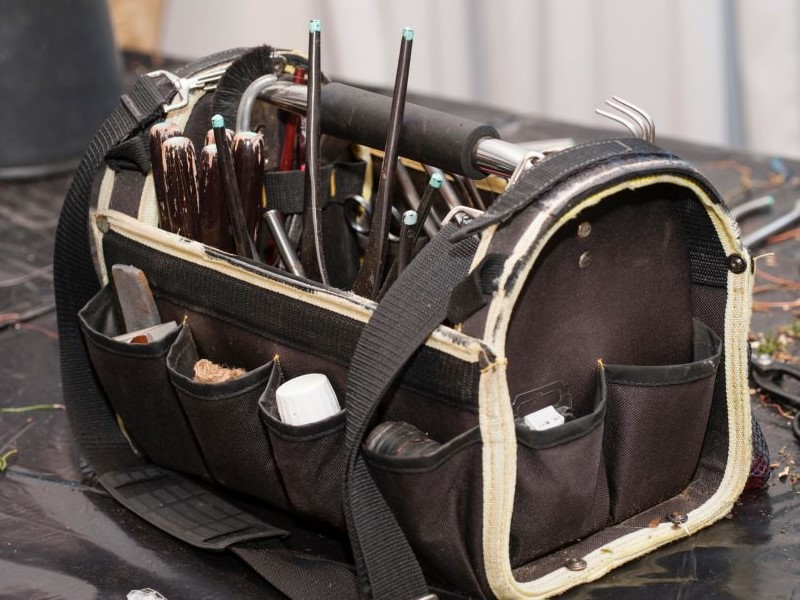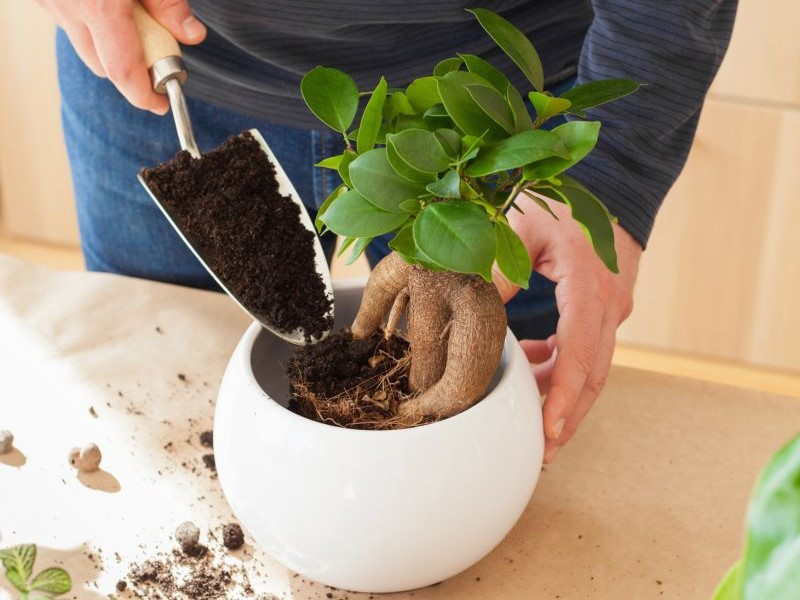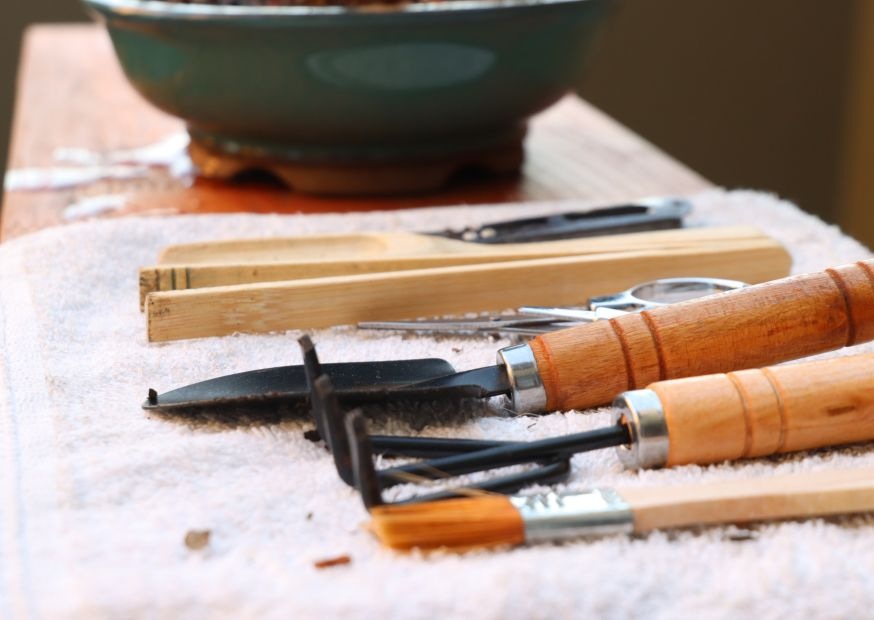In bonsai care, repotting and reviving are essential to your trees as planting. Central to this journey is a bonsai tool set, often overlooked yet crucial in the hands of bonsai enthusiasts. These practical companions steer the course of nurturing and breathing new life into our cherished bonsai trees.
Explore the essential side of tending to bonsai trees with us, where we unravel why these tools matter so much. Let’s make sense of the hands-on aspects of bonsai cultivation!
Why a Specialized Tool Set Matters

Bonsai trees demand precision and care that goes beyond what typical gardening tools can offer. Each tool in a specialized set is purpose-built to address specific aspects of bonsai maintenance. Take, for instance, bonsai shears. These are not your ordinary garden scissors; they are designed for meticulous trimming, allowing enthusiasts to shape bonsai’s intricate branches and foliage with finesse.
Using the right tools is more than a matter of convenience; it directly impacts the overall well-being of the bonsai. Precision in pruning, shaping, and repotting ensures the tree stays healthy and thrives. High-quality materials, like stainless steel and carbon steel, contribute to the longevity of the tools, making them reliable companions in the long-term care of bonsai trees.
In essence, a specialized tool set is the unsung hero in the bonsai world, addressing the unique needs of these miniature wonders and ultimately contributing to bonsai trees’ lasting health and beauty.
Essential Tools in a Bonsai Tool Set
When repotting and breathing new life into bonsai trees, a well-equipped bonsai tool set is akin to a skilled surgeon’s toolkit. Here, we break down the key essential tools for these activities.
Pruning Shears
The backbone of bonsai care, pruning shears are tailored for precision. They allow enthusiasts to shape their bonsai trees with finesse and are ideal for trimming branches and foliage during repotting.
Concave Cutters
Essential for clean and strategic cuts, concave cutters come into play during repotting to trim branches and roots. Their design promotes swift healing, ensuring the overall health of the tree.
Knob Cutters
An essential addition to the toolkit, a knob cutter is instrumental for creating clean and efficient cuts, mainly when dealing with larger branches or knots.
Wire Cutters
A vital tool for wiring, a wire cutter can help manage and guide branches into the desired position during repotting. They facilitate controlled growth, allowing enthusiasts to shape the tree’s form.
Root Hooks
Repotting involves delicately handling roots; they gently tease apart and untangle roots, ensuring minimal disruption and a smooth transition for the tree.
Bamboo Brush or Broom
Often overlooked but crucial, a bamboo brush or broom is handy for cleaning away soil and debris from the root system. This meticulous cleaning ensures a clear view of the roots and promotes a healthy repotting process.
Tweezers
Small and precise tweezers come in handy for intricate work during repotting. They assist in carefully maneuvering small roots and making adjustments with precision.
Root Rakes
Specially designed for separating and combing out roots, root rakes aid in preparing the root ball for repotting.
Moisture Meter
Assessing soil moisture is crucial during repotting. A moisture meter provides accurate readings, guiding enthusiasts in ensuring the right hydration balance for the newly repotted bonsai.
Choosing the Right Bonsai Tool Set
When venturing into bonsai, selecting the ideal bonsai tool set becomes a pivotal decision for enthusiasts. Among the considerations, the material of the tools plays a significant role. Bonsai tools come in various materials, such as stainless steel, aluminum, and alloys, each with advantages. The material choice can impact factors like weight, durability, and cost.
Another crucial consideration is the types of tools included in the set. Assess your specific needs, whether pruning shears for shaping or wire cutters for styling. Ensure the chosen set encompasses the essentials required for your particular bonsai projects.
Ergonomics and comfort are paramount when engaging in intricate bonsai work. Opt for tools with ergonomic designs that feel comfortable in your hands, enhancing the overall enjoyment of the bonsai care process.
Budget considerations play a role as well. Bonsai tool sets come in various prices, so balancing quality and affordability is essential. Look for a group that provides the tools you need within your budget.
Before finalizing your decision, check user reviews to gather insights from other bonsai enthusiasts. Real-world experiences can offer valuable perspectives on the practicality and durability of the tools.
Repotting Your Bonsai: Guide and Tools

To repot your bonsai effectively, start by gathering all the necessary tools. Assemble your bonsai tool set, including pruning shears, concave cutters, wiring tools, root hooks, and a bamboo brush or broom. Having all these tools on hand streamlines the process, making it more efficient.
Next, turn your attention to the new pot. Choose one slightly larger than the current pot, ensuring it has drainage holes. Begin the repotting process by placing a layer of fresh bonsai soil at the bottom of the new pot with a garden shovel or your hands. Carefully remove the bonsai from its current pot, using root hooks if the roots are tightly wound. Take a moment to inspect the roots for signs of rot or disease. Use pruning shears to trim away any dead or unhealthy roots, promoting the overall well-being of your bonsai.
Trim the smaller branches with pruning shears before placing the bonsai in the new pot. This helps maintain the desired shape and encourages new growth. Position the bonsai in the center of the new pot, ensuring the surface roots are spread evenly. Adjust the placement until you achieve the desired aesthetic. Gradually add bonsai soil around the roots, tapping gently to eliminate air pockets and ensure thorough coverage.
If wiring is necessary to secure the bonsai in the new pot, use wire cutters to trim the wire to the appropriate length. Wrap it around the tree’s base and anchor it to the pot for stability. Clean up the workspace using a bamboo brush or broom to remove excess soil from the surface.
Finally, water the bonsai thoroughly after repotting. This helps settle the soil and ensures proper hydration for the roots. Following these steps diligently will contribute to the health and beauty of your bonsai.
Also Read: When to Repot a Bonsai Tree? Seasonal Guide
Reviving a Stressed Bonsai: Tools and Techniques
When your cherished bonsai exhibits signs of stress, a thoughtful approach coupled with the right tools can make a significant impact. Begin by closely assessing the tree, looking for indicators such as wilting leaves or discoloration. Once evaluated, employ pruning shears to trim any yellowing or dead leaves, redirecting the tree’s energy to healthier parts. For diseased or decaying branches, turn to a concave cutter for precise removal, preventing the spread of issues and encouraging new growth.
Check the soil moisture with your fingers or a moisture meter, adjusting watering practices to achieve a proper balance. If root health is a factor in the stress, delicately use root hooks to inspect and loosen tangled roots, trimming any damaged or excessively long ones. Consider employing jin pliers to create deadwood features, enhancing aesthetic appeal and redirecting the tree’s energy for recovery.
For structural support during recovery, use bonsai wire to guide branches into a more balanced and aesthetically pleasing shape. Ensure the stressed bonsai receives adequate sunlight, adjusting its placement to optimize exposure, as sunlight plays a crucial role in the recovery process. Additionally, control humidity by placing a humidity tray or misting the foliage to create a more favorable environment.
Throughout this process, patience is key. Reviving a stressed bonsai takes time, and regular monitoring, adjustments, and celebrating small victories along the way contribute to a healthier and more vibrant future for your bonsai.
Maintenance Tips for Bonsai Tools

Keeping your quality bonsai tools in prime condition is essential for the success of your miniature tree endeavors. Here are straightforward maintenance tips to ensure it will remain effective and reliable:
Clean After Each Use
After every bonsai session, take a moment to clean your tools. Use a soft brush or cloth to remove soil, sap, or debris. This simple step prevents the accumulation of residue that can harm the tools over time.
Avoid Rust with Regular Oil Application
To prevent rust, apply a thin layer of oil to the metal parts of your tools. This is especially important for tools like shears and cutters that come in direct contact with the sap and moisture from your bonsai.
Sharpen Blades Regularly
Keep the blades of your pruning shears, concave cutters, and other cutting tools sharp. Regularly sharpening the blades ensures clean cuts, promoting the health of your bonsai and preventing unnecessary stress on the tools.
Inspect for Wear and Tear
Routinely inspect your tools for any signs of wear and tear. Check for loose screws, damaged handles, or misaligned parts. Promptly addressing issues helps maintain the overall functionality of the tools.
Use Bonsai Wire Mindfully
If you use bonsai wire for shaping, be mindful of its condition. Reuse the wire if possible, but remove it carefully to avoid damaging the branches. Inspect the wire for signs of weakness or breakage.
Clean and Store in a Dry Place
After cleaning:
- Store your bonsai toolset in a dry place.
- Avoid exposing them to damp or humid conditions, contributing to rust.
- Consider a toolbox or a designated area for storage.
Rotate Tool Usage
If you have multiple tools for a specific task, rotate their usage. This act prevents excessive wear on a single tool and ensures that all of it will remain in good condition.
Regularly Disinfect
When dealing with different bonsai trees, it’s a good practice to disinfect your tools to prevent the spread of pests or diseases. Use a mild disinfectant solution and wipe the tools thoroughly.
By incorporating these simple maintenance tips into your bonsai routine, you can extend the lifespan of your tools and enhance the overall success of your bonsai cultivation efforts.
Conclusion: Investing in Your Bonsai’s Future
Investing in your bonsai’s future is an investment in a living masterpiece. By dedicating time and care to repotting and revival, you are sowing the seeds of a resilient and flourishing bonsai tree.
The bonsai tool set you choose, having pruning shears to bonsai wire, becomes an instrument in crafting a story of growth and vitality. With each thoughtful touch, you nurture your bonsai and cultivate a relationship that evolves over the years.
So, embrace the journey, tend to your bonsai with love, and witness the beauty that blossoms—a testament to the enduring bond between caretaker and tree.
Happy Cultivating!






0 Comments